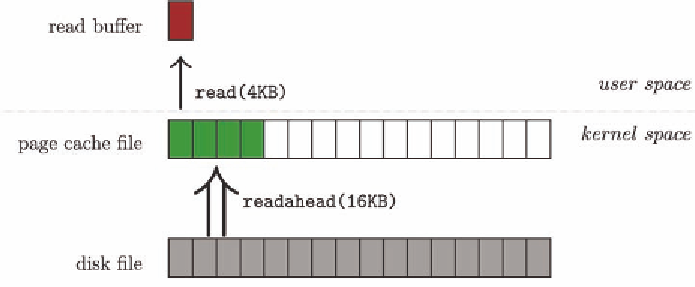Information Technology Reference
In-Depth Information
Figure 3. Page cache oriented read and readahead: when an empty page cache file is asked for the first
4KB data, a 16KB readahead I/O will be triggered
application provided I/O hints. Linux provides
a per-device tunable max_readahead parameter
that can be queried and modified with command
blockdev. As for now it defaults to 128KB for
hard disks and may be increased in the future. To
better parallelize I/O for disk arrays, it defaults to
2*stripe_width for software RAID.
Linux also provides madvise(), posix_fadvise()
and the non-portable readahead() system calls. The
first two calls allow applications to indicate their
future access patterns as normal, random or sequen-
tial, which correspondingly set the read-around and
read-ahead policies to be default, disabled or ag-
gressive. TheAPIs also make application controlled
prefetching possible by allowing the application to
specify the exact time and location to do readahead.
Mysql is a good example to make use of this facility
in carrying out its random queries.
This layer of indirection enables the kernel to
reshape “silly” I/O requests from applications:
a huge sendfile(1GB) request will be served in
smaller max_readahead sized I/O chunks; while
a sequence of tiny 1KB reads will be aggregated
into up to max_readahead sized readahead I/Os.
The readahead algorithm does not manage a
standalone readahead buffer. Prefetched pages are
put into page cache together with cached pages. It
also does not take care of the in-LRU-queue life
time of the prefetched pages in general. Every
prefetched page will be inserted not only into
the per-file radix tree based page cache for ease
of reference, but also to one of the system wide
LRU queues managed by the page replacement
algorithm.
This design is simple and elegant in general;
however when memory pressure goes high, the
memory will thrash (Wiseman, 2009), (Jiang,
2009) and the interactions between prefetching
and caching algorithms will become visible. On
the one hand, readahead blurs the correlation be-
tween a page's position in the LRU queue with its
first reference time. Such correlation is relied on
by the page replacement algorithm to do proper
page aging and eviction. On the other hand, in a
memory hungry system, the page replacement
algorithm may evict readahead pages before they
are accessed by the application, leading to reada-
the page cache
Figure 3 shows how Linux transforms a regular
read() system call into an internal readahead re-
quest. Here the page cache plays a central role:
user space data consumers do read()s which
transfer data from page cache, while the in-kernel
readahead routine populates page cache with data
from the storage device. The read requests are
thus decoupled from real disk I/Os.

Search WWH ::

Custom Search